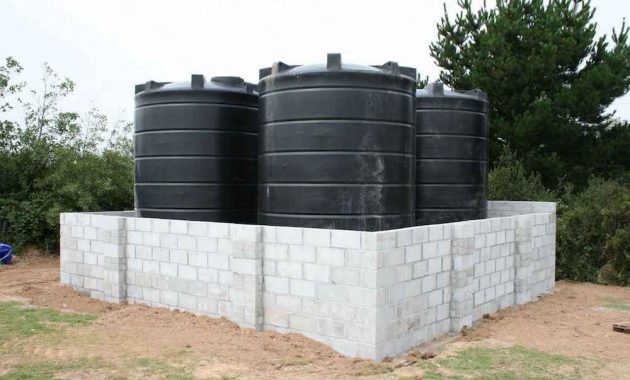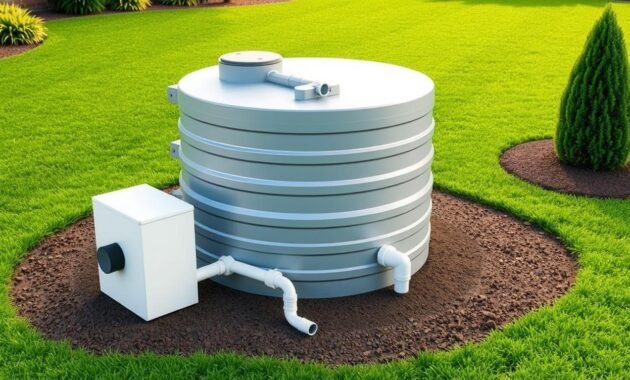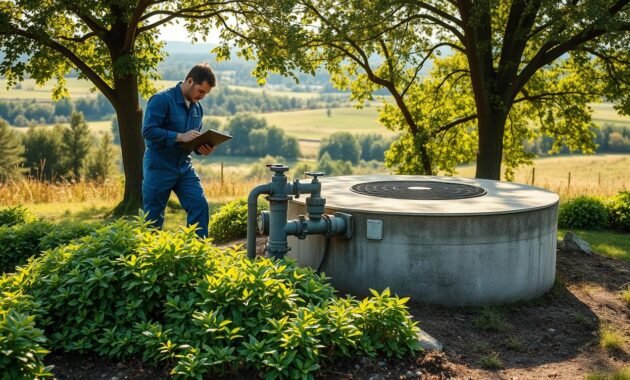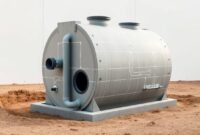Are you dealing with tough terrain that blocks traditional septic systems? Many homeowners face sewage issues when underground systems don’t work. Rocky soil, high water tables, and little space make wastewater management a big problem.
Above ground septic tanks and holding tanks are a new solution for hard-to-reach properties. These systems are flexible and efficient for sewage treatment in tough spots. I’ll show you how these above ground septic holding tanks can fix your toughest wastewater problems.
Whether you have a rural property or a challenging landscape, above ground septic tanks offer a reliable solution. They can greatly improve your property’s waste management.

Understanding Above Ground Septic Systems
Above ground septic systems are a smart choice for homes with tough terrain or little underground space. They offer great benefits for those looking for reliable ways to treat black water. Let’s explore how these systems efficiently handle household waste.
What Is an Above Ground Septic System?
An above ground septic system is a way to manage wastewater that sits on the surface. It’s different from traditional septic systems because it works well in areas with high water tables or rocky soil. It’s a flexible option for homes that can’t use underground waste management.
How These Systems Function
- Collect household wastewater from toilets, sinks, and showers
- Separate solid waste from liquid in the primary tank
- Filter and treat black water through a specialized drainage mechanism
- Distribute treated water through an elevated sand mound
Key Components and Design Features
Tanks have three main parts that work together:
- Septic Tank: Where waste is first treated
- Dosing Chamber: Houses the pump for controlled water distribution
- Sand Mound: Elevated bed for final water filtration
Each part is vital for effective wastewater management. This makes above ground septic systems a strong choice for homes facing unique environmental challenges.
Above Ground Septic Tank Types and Sizes
Choosing the right above ground waste tank is important. You need to think about your specific needs. There are different sizes and materials for various uses, like RV waste management and mobile home septic solutions.
Read also: Dirt Pad for Mobile Home
When picking an above ground septic tank for RV or mobile home, you have many options. Tank sizes range from 105 to 1000 gallons. They are designed for different household and temporary housing needs.
- Polyethylene tanks: Lightweight and cost-effective
- Fiberglass tanks: Durable and corrosion-resistant
- Concrete tanks: Heavy-duty and long-lasting
Before choosing an above ground septic tank for mobile home or RV, consider your waste management needs. The right tank depends on several factors.
| Tank Type | Capacity Range | Best Use |
|---|---|---|
| Compact RV Tank | 105-250 gallons | Small recreational vehicles |
| Mobile Home Tank | 300-500 gallons | Smaller residential settings |
| Large Residential Tank | 750-1000 gallons | Full-time living spaces |
Consider household size, water usage, and local rules. Getting professional advice can help find the best above ground waste tank for you.
Benefits of Installing an Above Ground Septic System
Above ground septic systems are a great choice for managing wastewater. They are compact and efficient, unlike traditional underground systems. Knowing what does a septic tank look like above ground reveals their clever design.
Environmental Advantages
- Enhanced groundwater protection
- Reduced risk of soil contamination
- Artificial vertical separation layer prevents direct water discharge
- Minimizes environmental impact in sensitive ecological areas
Installation Benefits
Are above ground septic tanks legal? Yes, they are! They work well in tough terrain where other systems can’t. They shine in:
- Rocky or shallow soil conditions
- Areas with high water tables
- Properties with limited underground space
- Regions with strict environmental regulations
Maintenance Accessibility
One big plus of above ground septic systems is how easy they are to maintain. They don’t need digging like underground systems do. This makes them:
| Maintenance Aspect | Above Ground Advantage |
|---|---|
| Inspection | Easy visual and physical access |
| Repairs | Minimal disruption to landscape |
| Component Replacement | Quick and cost-effective |
Choosing an above ground septic system means you’re picking a modern, efficient, and eco-friendly solution. It’s also super convenient and protective.
Common Applications for Above Ground Tanks

Above ground septic tanks are great for managing waste in many places. They are perfect for homes and mobile living spaces. Knowing where they work best helps you choose the right one for your needs.
Here are some common uses for above ground septic tanks:
- Residential properties with challenging terrain
- RV and camper waste management systems
- Temporary housing and construction sites
- Remote locations with limited infrastructure
For RV owners, an above ground septic tank is a top choice. It’s great for handling waste on the move. The cost varies from $500 to $3,000, based on size and features.
At home, these tanks are also a hit. They’re perfect for areas with hard-to-reach water or rocky soil. They’re easier to install and maintain, saving you money in the long run.
Construction sites and disaster relief areas also benefit from these tanks. They’re easy to set up and don’t need a lot of ground work. This makes them perfect for short-term needs.
When picking an above ground septic tank, think about your needs. Consider your location, how you’ll use it, and your budget. This will help you find the best tank for you.
Components of Above Ground Septic Systems
Understanding above ground septic systems is key for homeowners and wastewater experts. These systems have complex parts that work together to treat household wastewater.
Working with holding tanks, I’ve seen how each part is vital. Let’s explore the main components that ensure these tanks work well.
Septic Tank Structure
The septic tank is the heart of wastewater treatment. It’s made from strong materials like:
- Concrete
- Polyethylene
- Fiberglass
These tanks help separate solid waste from liquid. This is the first step in treating wastewater.
Dosing Chamber Details
The dosing chamber is a key part. It includes:
- Pump system
- Control floats
- High-water alarm float
This chamber makes sure wastewater is evenly treated. It prevents system overloads.
Sand Mound Configuration
The sand mound is the last step in treating wastewater. It’s built with sand and gravel layers. It has pipes that filter and purify the water.
Read also: How to Clean Water Pipes in Your House
Installation Requirements and Considerations
Setting up an above ground septic tank needs careful planning. I’ll show you the key steps for a successful and legal setup.
First, you must do a detailed site check. The look of an above ground septic tank can change, but where you put it is key. Local rules often set strict rules for where to place your septic system.
- Get the right permits from your local health department
- Do a professional soil test
- Check the distance from property lines
- Look at the ground slope and drainage
Important things to think about for your above ground septic tank include:
- Make sure maintenance vehicles can get there
- Keep it away from ground water
- Ensure good air flow around the tank
- Keep it safe from building foundations
It’s smart to hire experts for the job. Look for certified septic system pros who know the local area and rules. They can guide you through choosing the right spot, making sure your system works well and follows the law.
Getting the placement right is important. It can save you a lot of trouble and money later. Your septic system is a big investment in your property, so make sure it’s installed correctly.
Soil Requirements and Site Assessment
When planning an above ground septic system, knowing your property’s soil is key. Not all land is right for traditional septic setups. Above ground systems are a great fix for this.
Are above ground septic tanks legal in your area? It depends on soil type, groundwater levels, and local laws. These systems work well on tough terrain where regular septic systems can’t.
Percolation Testing: Understanding Soil Absorption
Percolation tests show how well your soil can handle wastewater. I suggest getting a pro to test:
- Soil texture and composition
- Drainage capabilities
- Water table depth
- Potential environmental impact
Groundwater Considerations
High water levels can make septic setup hard. Above ground systems are a smart choice when underground ones won’t work. They keep wastewater treated properly, even in tough spots.
Getting a pro to assess your site is the best way to find the right septic solution. Local experts can guide you through legal stuff and find the best way to manage black water.
Maintenance and Care Guidelines

Keeping your above ground septic tank for RV or mobile home in top shape is key. Regular care stops costly repairs and keeps your system running well for years.
I suggest making a maintenance schedule for these important tasks:
- Inspect the tank every 6-12 months for signs of wear or damage
- Check the sand mound for proper drainage and no soil erosion
- Monitor waste levels and schedule professional pumping
- Keep detailed records of all maintenance activities
For RV systems, maintenance needs are a bit different. These systems need more frequent checks because they move around. Pay close attention to:
- Seal integrity
- Connection points
- Waste tank capacity
- Potential leaks or cracks
Getting a professional to inspect your system is vital. They can spot issues early and save you money. They’ll check the tank, drainage, and make sure it meets health standards.
Managing your landscape is also important for your septic system. Don’t plant deep-rooted plants near the tank. Also, make sure water drains away properly to avoid overloading your system.
Cost Analysis and Investment Considerations
Buying an above ground septic tank needs careful money planning. Prices change based on several important factors. Knowing these helps you choose the right septic system.
Looking at the cost of an above ground septic tank, you’ll see different prices. Small tanks for campers or tight spaces start at $300. But, bigger systems for homes can cost up to $2,800 for a 1000-gallon tank.
Initial Installation Expenses
The first cost for an above ground septic tank depends on a few key things:
- Tank size and capacity
- Material quality
- Site preparation needs
- Local labor costs
Long-term Maintenance Expenses
Keeping your septic tank running well costs money over time. You should plan for:
- Annual checks
- Regular pumping
- Replacing parts when needed
Even though the initial cost seems high, these tanks can save money in the long run. They’re easier to maintain and can be cheaper in hard-to-reach areas.
Pro tip: Always ask for several quotes. Think about the total cost over time, not just the first price. Your specific needs will help find the best value for an above ground septic tank.
Conclusion
We’ve looked into above ground septic tanks and found key insights for managing waste. These tanks are great for homes, businesses, and mobile setups. They’re perfect for tough terrain or efficient waste systems.
We’ve covered the important parts of these systems, like their design and how to install them. Above ground septic tanks are more than a choice; they’re a smart investment. They work well in different environments, helping homeowners and managers a lot.
When thinking about waste management, remember these tanks are smart. They’re not just useful; they’re a clever way to handle wastewater. RV owners, rural developers, and those with special landscape needs will find big benefits in these systems.
My advice is to think about what you need, talk to waste experts, and look into these tanks. With the right planning and care, an above ground septic tank can be a reliable solution for years.


